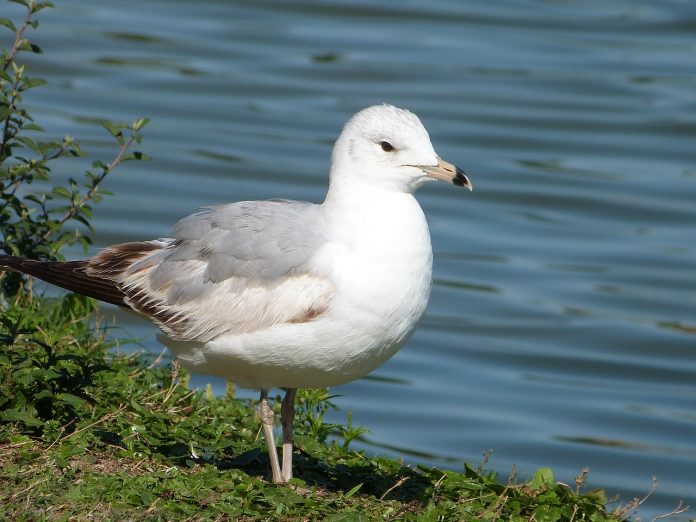Large groups of birds usually attract attention and curiosity. If several thousand crows roost in trees above someone’s driveway, I hear about it.
Or if during a mid-January thaw 400 robins show up and begin hunting for earthworms in a backyard, I’ll get a call.
The frigid, cold air that moved in a few days ago triggered another such phenomenon. Gulls suddenly appeared at fast-food restaurants, mall parking lots, and garbage dumpsters.
Sea gulls
And I heard about it. My email box overflowed with notes from readers asking why “sea gulls” were showing up at these places.
Before I explain, let me address the term “sea gull.”
If you have ever been to a coastal beach, you know what it means, but “sea gulls” are not limited to ocean beaches. In fact, Franklin’s gulls nest on the prairies of the northern Great Plains.
Bonaparte’s gulls nest on the edges of the boreal forest in Canada and Alaska. And California gulls nest near lakes throughout the west. Among ornithologists and birders, the term “gull” suffices.
Back to the original question — why did so many gulls show up last week when it turned cold?
Most of the winter gulls seen here in the inland east are ring-billed gulls and herring gulls. Both are common along the Atlantic coast in the summer, but large populations also nest inland on the many islands of the Great Lakes.
Wandering gulls
When winters are mild, they stay near the lakes. But when cold Canadian air masses plunge southward, gulls wander in search of open water. Small lakes can ice up quickly, but even the Great Lakes can freeze almost completely by mid-winter.
When this happens, gulls head south in search of open water. During the day, they scavenge at landfills, dumpsters, parking lots, and anywhere else they can find food.
At night, they roost (sleep) on ice near open water where they are relatively safe from predators.
This raises another interesting question. How do gulls (and ducks and geese, for that matter) roost on ice all night long without their feet freezing? They use an amazing network of blood vessels that act as counter-current heat exchangers to reheat blood as it returns from the feet to the body.
When blood flows into the feet, it cools quickly. But rather than freezing, venous blood flowing back to the body core is reheated by the warmer blood in the arteries that flows next to it.
Winter feet
Furthermore, bird feet can tolerate low temperatures because they contain mostly tendons and bones and little muscle or nerve tissue. Sometimes winter flocks of gulls draw attention from crowds of both birders and nonbirders.
In Pittsburgh, for example, when frigid temperatures settle in for a few days, as many as 10,000 gulls sometimes gather near the confluence of the Allegheny, Monongahela, and Ohio Rivers.
Most are ring-billed and herring gulls. Similar gatherings occur in New York near Buffalo and Niagara Falls.
So that’s why we see gulls in winter. Ice freezes them out of preferred places, and they head south for open water. In the spring when the ice thaws, the gulls return north to islands in the Great Lakes and beyond.
The most frequently seen winter gulls are ring-billed gulls. Adults are about 18 inches long and have a four-foot wingspan. The yellow bill is encircled by a black ring near the tip, hence its name.
Herring gulls, the other common winter species, resemble ring-bills, but are larger, about 25 inches long with a five-foot wingspan. The bill is yellow, and the lower bill has a red spot near the tip.
Opportunistic scavengers
In nature, gulls are opportunistic scavengers. They eat fish, carrion, crabs, insects, mollusks, and almost any sort of organic garbage, including French fries and hamburger buns.
Larger gulls can be quite predatory and even take small birds and mammals. If you’re puzzled by seeing gulls this winter, just look around.
It’s probably very cold, you’re probably just a few miles from a lake or river, and there’s probably an open dumpster nearby.














Thanks, Scott! As always: a great read and we all learn a lot.
P.S.
My bird feeder of late with our single digits here in No. Ohio has seen flocks of starlings and grackles! They appeared out of nowhere. Feisty and disruptive little devils they.
Well I haven’t seen any gull’s here in northern Michigan for a couple weeks. Maybe a few but not together, and I usually see them all over the McDonald’s parking lot. I just wondered where they went and I believe you have answered my question. Thanks.
you’re full of it pal. Im in Nova Scotia and the gulls on Pictou harbour don’t go anywhere just huddled on the ice all f%^&* winter. I go and feed them once in awhile. I still don’t know how they stay alive!! Neither do you>>